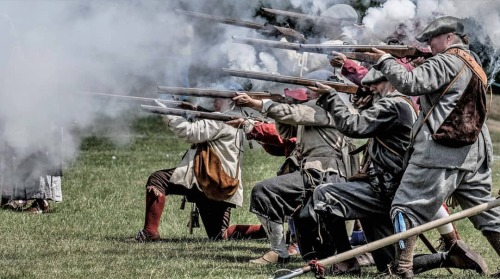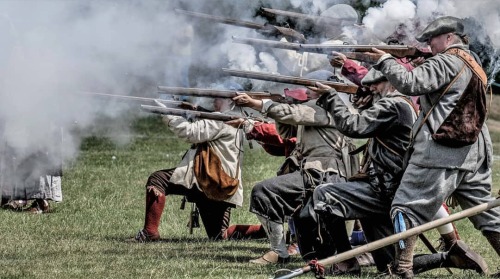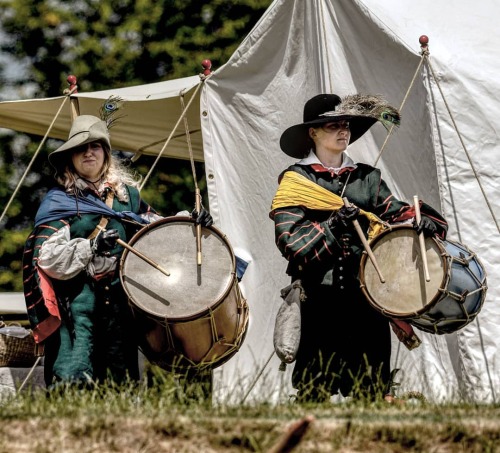#photoreenactment
“There is scarce a cottage in most of the southern parts of England but has its proportionable garden, so great a delight do most of men take in it” - English agriculturalist John Worlidge, 1677
.
In 17th Century England, virtually every house would have had a kitchen garden where both culinary and medicinal plants would be grown. In some cases – like onion or garlic – they would serve both purposes. Recipes for herbal treatments passed down through generations began to be compiled into handy compendiums in England such as Gerard’s Herbal (1597), Culpeper’s Complete Herbal (1653), Gervase Markham’s The English Housewife (1615), and The Gentlewoman’s Companion by Hannah Woolley (1673). These texts helped people prepare medicines for their families and neighbors, but even if they could not afford a book many households would use simple family recipe books, often called ‘receipt books’, to which they would add their own contributions.
.
Food was thought to have curative effects and different foods were ascribed properties similar to the traditional 'four humours’. They could be hot and dry (mustard, onions, or garlic), cold and wet (fish, lamb, cucumbers), or cold and dry (beef, legumes, or bread). The idea was to counteract the abundance of one humour by consuming a diet that included foods with the opposite properties.
.
#herbs #cooking #food #garden #gardening #gardens #gardenlife #gardenlove #nationaltrust #plants #photoreenactment #reenactment #reenactors #reenacting #reenactorstyle #reenactorslife #reenactorsofinstagram #reenactmentphotography #livinghistory #history #photohistory #historicalreenactment #17thcentury #sealedknot #dailyphoto #photoaday #photooftheday #photoadaychallenge #englishcivilwar #instadaily
https://www.instagram.com/p/CAOdyupnVJC/?igshid=17c6zyko15e48
Post link
“it is a wonder that men selected and packed off to war in this way … should ever have stood their ground at first musket fire.” - Stephen J. Stearns, ‘Conscription and English Society in the 1620s’
.
The historical record focuses much more on men who were forced to fight in the wars of the 17th Century than those who volunteered willingly, and so the view of military service in the Civil Wars is usually a negative one. This seems obvious in view of the account of the desperation that could drive one man to cut his own throat or another to cut off his own toe to avoid service. Men seized by recruiting partiesn for both sides were herded together and imprisoned before being marched off for minimal basic training and almost certain injury or death — the time-lapse between recruitment and action could be as little as three days. Desertion was a constant problem for armies relying on impressment, particularly Parliament’s “newly modelled” army, which was perennially short of both men and pay. Stories of almost half the impressed men who fought at Naseby fleeing the field or deserting soon after paint a vivid picture of unwilling recruits, unprepared for action. This image is sharply contradicted by reports from European sources, who noted English hardiness in war, and praises English and Scottish armies for their courage and resilience. As always, every soldier had his own story and this moment in history between the 'patronage’ armies of the medieval period and the professional armies of the late 17th Century onwards reveals so much about the many and varied reasons why men would march to war.
.
ABN Photography
.
#photoreenactment #reenactment #reenactors #reenacting #reenactorstyle #reenactorslife #reenactorsofinstagram #reenactmentphotography #livinghistory #history #photohistory #historicalreenactment #17thcentury #sealedknot #dailyphoto #photoaday #photooftheday #photoadaychallenge #englishcivilwar #instadaily #musketeers #musket #recruitment #recruiting #recruit
https://www.instagram.com/p/CAL5vc2HXhQ/?igshid=1vf1ku7x6nmuh
Post link
The midst of battle! There’s nothing like being caught up in the middle of a reenactment battle - and we’re missing it pretty badly right now! May is normally when the season really gets going and the recent sunny weather has made us pine for hot clothes and cold beers in warm fields! We’re already thinking to next year when, hopefully, life will be getting back to normal and we can see our friends again. If you’re interested in joining up in preparation for a great new experience, check out our website by clicking on the link in our bio!
.
Craig Wilkinson
.
#hobby #fun #battle #giveitago #trysomethingnew #activities #photoreenactment #reenactment #reenactors #reenacting #reenactorstyle #reenactorslife #reenactorsofinstagram #reenactmentphotography #livinghistory #history #photohistory #historicalreenactment #17thcentury #sealedknot #dailyphoto #photoaday #photooftheday #photoadaychallenge #englishcivilwar #instadaily
https://www.instagram.com/p/CAJSMrwHboH/?igshid=essbgvnm6z5s
Post link
Contrary to popular notions of set piece clashes filled with dashing cavalry charges and tens of thousands of soldiers, sieges were every bit as important as battles in the English Civil Wars - and that’s where cannons came in handy!
.
Both sides possessed their own ‘siege trains’ of varying sizes – slow-moving convoys of cannons, their crews, impressed ‘pioneers’, and siege experts that would travel separately to the main army and would be called upon to lay siege to an enemy fortification while the larger force moved on. These trains could include a wide variety of different guns, from ‘cannon royal’ to ‘culverins’, 63-15 pounders, and mortars of various sizes.
.
Sieges could be a costly business, both in terms of resources and manpower. In his 1671 treatise Observations, George Monk – who had fought on both sides in the English Civil War – wrote “Every Commander knows that mans flesh is the best fortification that belongs to a Town; and where a Town is well manned, the best way of taking it is by Starving; and when a town is weakly manned, the best of taking it is by Battery and Assaults, or by Approaches, Mining, Battery, and Assaults”
.
Find out more at https://earlofmanchesters.co.uk/siege-warfare-in-the-english-civil-wars/
.
@johnbeardy
.
#siege #cannon #guns #cannons #castles #flare #fire #smoke #photoreenactment #reenactment #reenactors #reenacting #reenactorstyle #reenactorslife #reenactorsofinstagram #reenactmentphotography #livinghistory #history #photohistory #historicalreenactment #17thcentury #sealedknot #dailyphoto #photoaday #photooftheday #photoadaychallenge #englishcivilwar #instadaily
https://www.instagram.com/p/CAGuTW2H8Ke/?igshid=1wjzb3u324ndy
Post link
#Onthisday in 1645, the Royalist commander in Scotland, the Earl of Montrose, scored another spectacular victory against the Scottish Covenanters at the Battle of Auldearn. Outnumbered by more than two to one, Montrose destroyed half the Covenanter forces arrayed against him. With limited resources at his disposal Montrose had already secured a series of victories over Covenanter forces across the Highlands of Scotland. His latest assault on Dundee however was not so successful, and so Montrose retreated northwards, closely pursued by a Covenanter detachment commanded by Sir John Hurry.
.
Having joined forces with local militia loyal to the Covenanter cause, Hurry led a surprise attack on Montrose’s position close to the village of Auldearn, early in the morning of the 9 May. The intense fighting that followed continued for much of the day, with attack and counter attack until the Covenanter army finally broke and fled. Many of the casualties were inflicted in the merciless pursuit that continued for 14 miles.
.
Montrose’s string of victories would make him master of Scotland, with the Covenanter leaders even fleeing to England as he took Glasgow. But his fortune ran out in August 1645 at Philiphaugh. His first major defeat was decisive and he was unable to pose a serious threat to the Covenanters again. After the surrender of King Charles in England, Montrose received orders to disband his remaining forces. He negotiated terms for surrender in July 1646 and sailed away into exile in Norway on 3 September.
.
Levitt Parkes
.
#scotland #scottish #scottishhistory #auldearn #battle #musket #photoreenactment #reenactment #reenactors #reenacting #reenactorstyle #reenactorslife #reenactorsofinstagram #reenactmentphotography #livinghistory #history #photohistory #historicalreenactment #17thcentury #sealedknot #dailyphoto #photoaday #photooftheday #photoadaychallenge #englishcivilwar #instadaily
https://www.instagram.com/p/B_8tDc5Ham-/?igshid=zkl5fpv1kb1w
Post link
#Onthisday in 1645, the Royalist commander in Scotland, the Earl of Montrose, scored another spectacular victory against the Scottish Covenanters at the Battle of Auldearn. Outnumbered by more than two to one, Montrose destroyed half the Covenanter forces arrayed against him. With limited resources at his disposal Montrose had already secured a series of victories over Covenanter forces across the Highlands of Scotland. His latest assault on Dundee however was not so successful, and so Montrose retreated northwards, closely pursued by a Covenanter detachment commanded by Sir John Hurry.
.
Having joined forces with local militia loyal to the Covenanter cause, Hurry led a surprise attack on Montrose’s position close to the village of Auldearn, early in the morning of the 9th May. The intense fighting that followed continued for much of the day, with attack and counter attack until the Covenanter army finally broke and fled. Many of the casualties were inflicted after the Covenanter army broke and fled, in a merciless pursuit which was continued for 14 miles.
.
Montrose’s string of victories would make him master of Scotland, which the Covenanter leaders even fleeing to England as he took Glasgow. His fortune ran out in August 1645 at Philiphaugh. His first major defeat was decisive and he was unable to pose a serious threat to the Covenanters again. After the surrender of King Charles in England, Montrose received orders to disband his remaining forces. He negotiated terms for surrender in July 1646 and sailed away into exile in Norway on 3 September.
.
Levitt Parkes
#scotland #scottish #scottishhistory #auldearn #battle #musket #photoreenactment #reenactment #reenactors #reenacting #reenactorstyle #reenactorslife #reenactorsofinstagram #reenactmentphotography #livinghistory #history #photohistory #historicalreenactment #17thcentury #sealedknot #dailyphoto #photoaday #photooftheday #photoadaychallenge #englishcivilwar #instadaily
https://www.instagram.com/p/B_8tDc5Ham-/?igshid=7k9arpk7zjzn
Post link
“Of Trumpet and of Drum
That makes the Warrier’s stomack come,
Whose noise whets Valour sharp, like beer
By thunder turn’d to vinegar, (For if a Trumpet sound, or Drum beat, Who has not a month’s mind to combat?)” - Francis Markham, Five Decades of Epistles of Warre (1622)
.
One key role in which drums were used during the English Civil War was literally “drumming up business” for recruiting parties. These gangs, typically made up of a captain, sergeant, corporal, drummer, and two privates would stand before a “drum-head”, literally an upended drum that served as a makeshift desk, display a flag, and make heroic speeches before calling men to them and offering them a “bounty,” which varied according to the reluctance of recruits: 5 shillings in 1660; £1 in 1672; £2 in 1703. By 1708 the offer was £4 per man for just three years’ service. The drum would be an important part of these parties, luring potential recruits with its martial tunes and rousing sound. It might also be joined by other instruments: a bagpipe, a fife, an oboe, or even a trumpet - anything to grab and hold attention!
.
Levitt Parkes
.
#drum #drummer #drumming #drums #drumstagram #music #militarymusic #photoreenactment #reenactment #reenactors #reenacting #reenactorstyle #reenactorslife #reenactorsofinstagram #reenactmentphotography #livinghistory #history #photohistory #historicalreenactment #17thcentury #sealedknot #dailyphoto #photoaday #photooftheday #photoadaychallenge #englishcivilwar #instadaily
https://www.instagram.com/p/B_3aMDHHzLI/?igshid=h3w7z7mfnb5h
Post link







